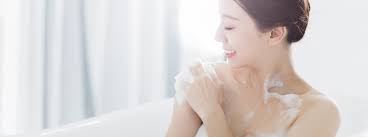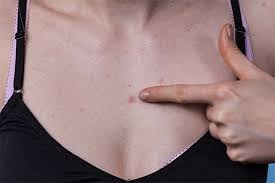What causes Chest Acne?
Although acne treatments are often debated for areas such as the nose and chin, acne is not limited to the face. Acne can appear anywhere on your body, including your chest, if you’re more susceptible to it due to risk factors like hormones or oily skin.
When the pores get clogged, acne grows. Pores can be found all over your body, including your chest. You can note the following forms of acne on your chest if you have acne-prone skin:
- blackheads.
- Cysts are a form of a cyst.
- acne scars.
- whiteheads.
- pustules are a form of pustule.
While chest acne isn’t as noticeable as pimples on the face, it can still be painful. Here are eight ways to prevent pimples clear a breakout once they’ve formed.
- Take a shower every day.

If you don’t shower every day, you’re more likely to get chest acne. Showering regularly aids in the removal of elements that clog the pores. This contains the following:
- bacilli
- skin cells that have died
- sand
- hydrocarbons (sebum)
Make sure you shower every day to reduce the risk of getting chest acne. This includes the warmer, drier months where you do not think you need to shower. For the best performance, use lukewarm (not hot) water. Consider finishing with a cold water rinse to help close your pores.
- Using an anti-acne body wash.
Salicylic acid-based body washes are particularly beneficial for chest acne. Salicylic acid is a drying agent that is used to treat acne.
Try using one of the following body washes to treat chest acne:
- Neutrogena Body Care Body Wash Neutrogena Body Care Body Wash Neutrogena Body Care.
- Cleansing Body Bar ProActiv+
- Tea Tree Skin Clearing Body Wash from The Body Shop.
- Exfoliate the skin once a week.
Dead skin cells emerge to the surface (epidermis) to make room for new skin cells as part of the cell turnover process. Dead skin cells, on the other hand, don’t always shed on their own. They can clog your pores and trigger acne if you don’t get rid of them.
This is where exfoliation can come in handy—the procedure aids in removing dead skin cells, preventing clogging of pores and acne formation. You’ll probably note that your skin is significantly smoother. The trick is to exfoliate once a week or less; doing so more often will irritate preexisting blemishes.
Experiment with:
- Honey Almond Exfoliating Body Bar by C. Booth.
- Visibly Clear Gentle Exfoliating Wash by Neutrogena.
- Tea Tree Squeaky-Clean Exfoliating Face Scrub from The Body Shop.
- Use a non-comedogenic body lotion.
Non-comedogenic literally means non-pore-clogging in layman’s words. When it comes to things that remain on your skin all day or night, such as body lotion, this is important.
Non-comedogenic body lotion will hydrate the skin without causing acne when applied to the chest. Some lotions also have a small amount of salicylic acid in them to help clear up previous breakouts. It would help if you also stayed away from fragrances that irritate your skin.
Take a look at the following body lotions:
- Daily Moisturizing Lotion by Aveeno.
- Body Hydrating Cream by Dermalogica.
- Body Lotion by Neutrogena.
- Experiment with spot treatments.
By shrinking pimples and curing the underlying inflammation, spot therapies will help with chest acne breakouts.
Many over-the-counter (OTC) spot treatments are available, and most of them contain salicylic acid or benzoyl peroxide. Salicylic acid is the better of the two ingredients because benzoyl peroxide is infamous for bleaching clothes. When applying salicylic acid to vast areas of the body, there’s a risk of toxicity, so use it only for spot treatments on the chest.
You may also try any of the following natural and home remedies. Before applying any solution to your chest, conduct a patch test to ensure no adverse reactions. Choose a small area on your arm and wait 24 hours to see if it develops a rash or discomfort.
Purchase spot treatments from the comfort of your own home.
Tea tree oil is a natural antiseptic:
Tea tree oil is a common alternative skin treatment for acne and other skin problems. According to the Mayo Clinic, products containing 5% of this oil may be just as effective as products containing 5% benzoyl peroxide. Patience, on the other hand, is the secret. Tea tree oil takes a little longer to function than most drugs.
If you’re hesitant to try pure tea tree oil, don’t worry: the oil is used in various over-the-counter acne items. Topical oils, gels, and wipes are only a few of the spot care solutions available at The Body Shop.
Tea tree oil can be purchased online.
Honey and cinnamon:
When applied to the chest, cinnamon and honey will potentially produce an effective acne-fighter. Cinnamon has antimicrobial properties, and raw honey can be used to battle bacteria. These ingredients, when used together, can help to reduce acne-causing bacteria and inflammation. Weekly or when required for new blemishes, these are safe to use.
To make this, combine one teaspoon cinnamon with two teaspoons raw honey until a paste develops. You can use the mask all over your chest for 30 minutes and then rinse it off, or you can use it as an overnight spot treatment.
Charcoal or mud:
Try a mud or charcoal mask if you’d rather use a natural remedy that’s already made in a bottle. These may be used as all-over treatments or on specific areas of your chest. Acne is treated with mud and charcoal, both of which work by drawing out impurities. These ingredients can also help to soften your skin. The Yes to Tomatoes Detoxifying Charcoal Mud Mask is one example. For best performance, use once a week.
- Play with various laundry detergents.
Washing your clothes is important for keeping germs at bay, but it can also help avoid acne if you have oily skin. Laundry detergent, on the other hand, may also have the opposite effect, causing acne.
This can happen if you use some detergents that irritate your skin. Products containing fragrances and dyes fall into this category. When you wear a shirt that has been washed with allergenic detergents, you risk a breakout on your chest and other parts of your body.
Look for “hypoallergenic” labels on laundry detergents.
Online retailers carry hypoallergenic laundry detergent.
- Dress in loose, breathable fabrics.
Wearing loose, non-irritating clothing that helps your skin breathe is another way to keep chest acne at bay. Tight clothing can trap dirt, bacteria, and oils, causing blemishes to appear. Wool, nylon, and spandex, for example, will irritate the skin even more. Cotton clothing is the safest option.
- Drink plenty of water.
Acne may need internal treatment as well. Although it’s debatable if those foods cause acne, there’s no denying that water may aid. Not only does water keep you hydrated, but it also aids in the removal of contaminants.
To enjoy these benefits, you can drink eight glasses of water per day. Swapping sodas and other drinks for water over time can decrease chest acne and a better skin complexion.
When do you see a dermatologist?
Acne treatments can take up to ten weeks to completely function, so be patient. If you haven’t had any results after a long period, it’s time to see your skincare expert.
Your skincare doctor will help you get rid of chest acne for good by administering topical or oral acne drugs. These types of drugs are used daily to treat and prevent extreme acne. Oral contraceptives can help women with body acne in some cases. Your dermatologist can prescribe antibiotics to treat extreme inflammation caused by cysts and other types of severe acne.
The reality of acne on the chest:

Acne is a common skin disorder that affects almost everyone at some stage in their lives.
Acne is caused by a buildup of dead skin cells that clog your pores, resulting in an overabundance of a bacteria called propionibacterium acne on your skin. As a result, the skin becomes inflamed, resulting in the formation of whiteheads, blackheads, or pimples.
Acne knows no bounds, which is an unfortunate fact. Teenagers are more likely to be affected, but it can affect people of all ages. And I see it in men and women almost similarly. Acne may appear anywhere on your body that has oil glands, such as your back, face, stomach, or chest.
Chest acne occurs in the same way as acne on other parts of your body does, but it is affected by a variety of factors, including:
Using skin care items that help to avoid or slow down the loss of water
Friction caused by clothing
Sweating excessively
It’s important to understand that chest acne isn’t caused by a lack of hygiene. It’s not caused by dirty skin, and harsh soaps or chemicals, as well as rough scrubbing, can make it worse.
Acne can also be aggravated by the following factors:
Corticosteroids, testosterone, and lithium are examples of drugs.
Hormonal changes, such as those associated with puberty and pregnancy, may cause your glands to produce more oil, resulting in more acne.
Diet — According to some reports, skim milk, chocolate, and high-carbohydrate foods can aggravate acne. If patients wish, I address this with them and prescribe a mild, rather than restrictive, approach to restricting these foods.
Stress — When the body is under stress, it releases androgens, which affect different parts of the body, including the skin. These hormones can stimulate hair follicles and oil glands in the skin, causing more inflammation and acne to develop.
There are a variety of remedies for chest acne that can help you prevent skin marks, hide acne, and reduce the emotional stress caused by acne. To avoid clogged pores, use gentle scrubs and noncomedogenic creams. Mild inflammatory acne can be relieved with over-the-counter body washes that contain salicylic acid and benzoyl peroxide. Often, coarse or rough body scrubs are abrasive to the skin and should be avoided.
If over-the-counter drugs aren’t helping, speak to your doctor about oral and topical treatments that can help you treat your acne.

